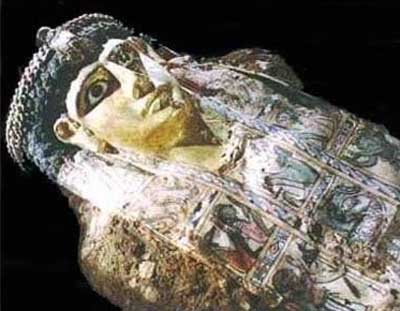
The Tombs and Mummies of Bahariya Oasis
The Valley of the Golden Mummies is a huge burial site at Bahariya Oasis in the Western Desert of Egypt, discovered in 1996. Dr. Zahi Hawass, with his Egyptian team, have found around 250 mummies dating to several different periods in history. The site dates to Greco-Roman Egypt, where the ruin of a temple to Alexander the Great can be found. It is believed by some Egyptologists that the Greek conqueror passed through Bahariya while returning from the oracle of Ammon at Siwa Oasis. Excavations of the Greco-Roman necropolis, known as the Valley of the Golden Mummies began in 1996. Approximately thirty-four tombs have been excavated from this area so far. Hawass estimates more than 10,000 will be uncovered.
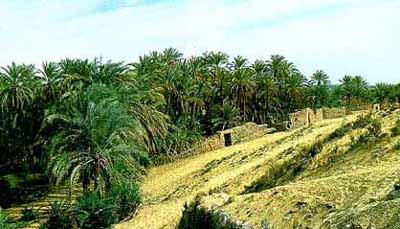
Set in a depression covering over 2000 sq. km., Bahariya Oasis is surrounded by black hills made up of ferruginous quartzite and dolorite. Most of the villages and cultivated land can be viewed from the top of the 50-meter-high Jebel al-Mi'ysrah, together with the massive dunes which threaten to engulf some of the older settlements. The Oasis was a major agricultural center during the Pharaonic era, and has been famous for its wine as far back as the Middle Kingdom. During the fourth century, the absence of Roman rule and violent tribes in the area caused a decline as some of the oasis was reclaimed by the sand. Wildlife is plentiful, especially birds such as wheatears; crops (which only cover a small percentage of the total area) include dates, olives, apricots, rice and corn.
Over time, the Bahariya Oasis has had a number of different names. It has been called the Northern Oasis, the Little Oasis, Zeszes, Oassis Parva and the especially during the Christian era, the Oasis of al-Bahnasa, along with various other names. At one time, the Bahariya Oasis, as well as most of the rest of what is today referred to as the Western (or Libyan) Desert, was the floor of an immense ocean. Yet from about 3000 BC until the present, almost no rainfall graces this part of the world, so groundwater is its life blood.
Remains of stone tools found in the Bahariya oasis evidence the existence of settlements in the area as early as the Paleolithic Period. In fact, we are told that anyone with a trained eye, walking about the oasis, can spot prehistoric stone knives and and axes simply lying upon the surface of the sand.
However, little real excavation has been carried out in the Oasis, at least until the last several years, and so we know little of the history of the Bahariya Oasis prior to Egypt's Middle Kingdom. What we do know comes mostly from the work of Ahmed Fakhry, and 20th century Egyptologist, who worked in the Oasis. Otherwise, most of the archaeological investigation has been carried out by the local antiquity authorities, and some recently by Zahi Hawass.
It is possible that during the Old Kingdom there may have been a governor appointed to the Bahariya Oasis, as there was in Dakhla, but so far we have no hard evidence that might support such an argument. In fact, we hear of a people known as the Tjehenu, who inhabited the Western Desert and were fair skinned with blond hair and blue eyes, and with whom the early Egyptian's fought. However, its seems that the Bahariya Oasis was originally inhabited by a mix of people from the Nile Valley and Bedouins from Libya. At that time, evidence suggests that the Oasis was much larger than it is now, but no settlements dating to the Predynastic, Early Dynastic or Old Kingdom have thus far been unearthed.
By the Middle Kingdom, Bahariya was known as Zeszes, and definitely fell under the control of the Egyptian kings, though only a single scarab (inscribed with the name of Senusret) from that period has been found in Bahariya. Yet, documentary evidence provides that both Amenemhet and Senusret II began to pay considerable attention to the Oasis, probably to deflect regular attacks from the Libyans. At that time, there must have been large agricultural estates, large houses for the landowners, and even military garrisons to keep marauders at bay. Agriculture was, as it is now, of major importance to this community, and wine, as well as other goods of the Oasis, made their way from here to the Nile Valley by donkey caravans along two different routes.
However, during the 15th Dynasty, when Egypt was under the rule of the Hyksos kings from Palestine, there was a lapse in trade with the Oasis, presumably because the trade routes were unsafe. At that time, we find only one text that refers to the Oasis, when King Kamose refers to it as DjesDjes, the word for the region's famous wine.
According to Fakhry, under Tuthmosis III, many improvements were made in the Oasis, including new water wells. His reign marked an increase in the local population. At this time, the Oasis was under the control of Thinis (Abydos), to which they paid tribute. We find visual evidence of this in the private tomb of Rekhmire, who was Tuthmosis III's vizier. One scene portrays the people of the Oasis, wearing striped kilts, presenting gifts of mats, hides and wine.
However, the Oasis apparently had at least a governor who was a native of Bahariya, for the oldest tomb so far discovered in the Oasis is that of Amenhotep Huy, where his title is given as "Governor of the Northern Oasis". The tomb is dated to the end of the 18th Dynasty or the beginning of the 19th. By the 19th Dynasty of Egypt's New Kingdom, the Bahariya Oasis became even more important because of its mineral abundance. Even today, the mining of iron ore continues to be a vital industry. Even Ramesses II, in the Temple of Amun at Luxor, refers to the Bahariya as a place of mining. Of course agricultural products continued to be important in the Oasis, including dates, grapes, figs, livestock and pigeons (for food).
By the time of Merenptah, Ramesses II's son, Egypt was suffering from Libyan attacks, and the Bahariya, as well as the other Western Oasis, must have suffered considerably during this time. Ramesses III defeated the Libyans, and bought back some order to the desert region. However, it was not until the Third Intermediate Period and particularly the Late Period that Bahariya emerged as a major Egyptian center.
Shoshenq I, who founded the 22nd Dynasty under Libyan rule, along with Shoshenq IV, seemed particularly interested in the Oasis. In fact, Fakhry believed that the Libyans first captured the Farafra and Bahariya Oasis to use as a base for their conquest of Egypt. They developed the region, and ordered that government officials live in the community. We hear of an official during this period named Weshet-het, holding the title "Superior Libyan Chief", who was probably a governor, as well as another named Arcawa who became governor and priest at the end of the 22nd Dynasty. Many of its known antiquities date from this period.
Yet it was not until the 25th and 26th Dynasties that the Bahariya Oasis florished as an important agricultural and trade center. Specifically, by the 26th Dynasty, Bahariya prospered with its own governors who were natives of the oasis. They apparently continued to report to Abydos, where there apparently remained a governor over all of the Oasis. By the time of Ahmose II (570-526 BC), the importance of the Bahariya Oasis was fully understood. He sent troops into the Western Desert to defend Egyptian interests against the Greeks and Libyans, and acted vigilantly to protect this Oasis. To honor him, two temples were erected, along with a number of chapels near Ain el-Muftella (near El Bawiti). These temples were embellished even into Egypt's Persian period.
During the Persian period that followed a series of takeovers by the Nubians and Assyrians, a strong military presence and garrison were established in the Bahariya Oasis. They may have been responsible for some of the antiquities that have been attributed to the Romans. However, they could not stop the conquest of Egypt by Alexander the Great, once he decided to make Egypt his own.
t is very possible that Alexandria the Great traveled through the Bahariya Oasis on his way to the Oracle of Amun at Siwa. At first, Egypt was a organized under a centrally controlled government headed by Alexander's commander, Ptolemy, and the Bahariya Oasis immediately began to prosper. Not only were trade routes reestablished, but the Greeks used the Oasis to establish control over the rest of the Western Desert. In fact, they set up an extensive, permanent military garrison to protect the trade routes. During the Roman and Greek Periods, we seem to know more about the Bahariya Oasis than from any other period of time, though, as more archaeology is investigated, we stand to know much more. It was during the Greek period that the cemetery known as the Valley of the Golden Mummies came into existence.
During the Greek period, we know that Thoth was worshiped in the Oasis, particularly in his Ibis form, while Hathor is referred to as the "Lady of Bahariya Oasis". Khonsu, the moon god and Amun were both called "Lords of the Bahariya Oasis", though Amun was dominant. Attesting to Thoth's popularity is Qarat al-Farargi (Hill of the Chicken Merchant) which in actuality is the burial gallery of the Sacred Ibis, and one of the most extensive antiquities in the Bahariya Oasis. Its name comes from the fact that the local inhabitants once believe the mummies were those of chickens.
We now know that at the end of the Greek Period, perhaps when the Greeks and Romans were battling for control of the Oasis, the irrigation systems fell into somewhat of a state of decline. Even after the Romans establishing their rule over Egypt, life in the Oasis was a harsh period, when marauders often roamed about terrorizing villages, and life was very dangerous.
However, the Romans were also hard on those residing in the Nile Valley, and recent evidence suggests that people in the Bahariya Oasis may have suffered their rule more comfortably than other Egyptians. The Romans made many improvements within the Oasis, building an impressive series of aqueducts (possibly) and wells, several of which are still used in Bawiti and Izza today.
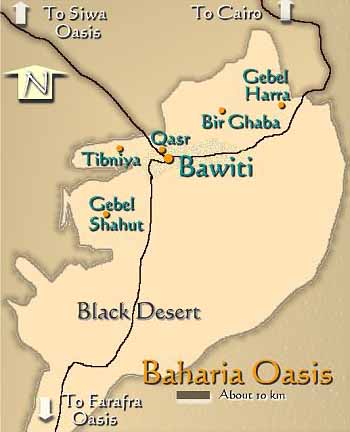
This oasis was important to the Romans as a breadbasket, and we find many tombs dug into the sides of the Bahariya mountains during Roman times. There were public works projects, new agricultural communities were formed, roads were cut, and thousands of mud-brick buildings were constructed. Roman soldiers often moved between Oxyrhynchus in the Nile Valley and Bahariya, where there was a major occupation in the northern part of the Oasis east of Bawiti.
During the Christian period, when Egypt continued under Roman rule, Bahariya was known as the Oasis of al-Bahnasa. This was apparently not particularly a safe time for the Oasis. We know that a Roman commander by the name of Hadrian oversaw the military forces at Bahariya around 213 AD, but we also hear of a Libyan invasion by the Nobatai people who destroyed many of the Oasis villages. By 399, additional Roman and now Byzantine military camps bordered the Oasis.
It has been suggested that the Oasis was never fully Christianized, as was much of the rest of Egypt. However, though the pagan gods may have lived on, perhaps even into the Islamic era, there was enough of a Christian community that the oasis had its own Bishop. Notably, Coptic tradition holds that St. Bartholomew, one of Jesus Christ's original twelve Apostles, was sent to the oasis in order to convert the local population. However, Abu Salih tells us that Bartholomew was martyred in the oasis, though others say he died on the sea coast. Regardless, Abu Salih tells us of many churches in the area, including a church named after Saint Bartholomew.
As late as 1931, Dugald Campbell tells us of a monastery that still stood in Bawiti, the Oasis' capital. He refers to it as Dar al-Abras, the Lepers' Refuge, and says that it had engraved crosses on the walls, paintings, and contained many old writings. At that time he says the Christians called Bahariya Mari Girgis (St. George). He further records the discovery of "old baked-earth coffins of the kind made in Carthage during the Punic period", each with the figure of a Libyan man on the lid. Apparently he took some of these, discovered in the Bahariya rock tombs, back to the Cairo Antiquities Museum.
Bahariya was known as the Northern Oasis, or sometimes as Waha al-Khas during the early Islamic period. How exactly the religious pecking order of the Bahariya was made up during the Christian and Islamic periods is unclear, but it is evident that the Oasis had a considerable Christian community until the 16th or 17th century. Amir Ibn el-As, the commander of the Arab army that conquered Egypt, sent troops under Uqba Ibn-Nafea to insure political stability within the Western Desert, but apparently the more remote areas did not immediately adopt Islam.
Islam migrated into the Oasis from two different directions, both from Libya and the Nile Valley. It has been theorized that, at least during its earliest phase, those converted to Islam were not Christians, but left over pagans from the old religions. During this period, the oasis suffered considerably, as did most places in the Western Oasis. We here of sand dunes covering cultivated land, and gone was the trade in wine due to the edicts of Islam. Taxes were now levied against dates and olive oil. Much of this period is relatively unknown to us, but the Fatimids, who had affiliations in Libya, may have crossed the desert in the conquest of Egypt at Bahariya.
Muhammad Ali, often sited as the founder of modern Egypt, made claim to the Bahariya Oasis, including Farafra and Hayz, as early as 1813, before bothering with any of the other oasis. He executed a tribute of 2,000 Spanish piasters annually, and Wilkinson says he later raised this to 20,000 reals. Apparently, this created problems, because unlike Kharga, Bahariya required a large force of between 400 and 500 men to maintain peace within the oasis.
However, once Muhammad Ali applied his rule to the Oasis, travelers began to visit the area. The first documented modern westerner to visit was the adventuring strongman, Belzoni. He called the Oasis Wah al-Bahnasa, or Wah al-Mendeesheh, and traveled there from the Fayoum in May of 1819, about the time Muhammad Ali was beginning his conquest of the other Western oasis. However, Belzoni actually thought he was in Siwa.
Thereafter, a number of explorers visited the Oasis, including Gailliud in 1820, who recorded a number of monuments that no longer exist, including the Roman victory arch at El Haiz. The Roman arch, as well as other monuments may have suffered from an earthquake that was recorded as a level eight disturbance in the Fayoum Oasis in 847. Hyde visited the Oasis in February of 1820, Pacho and Muller between 1823 and 1824 followed by Wilkinson in 1825, the Rohlfs expedition which arrived in 1874 and Captain H. G. Lyons in 1894. In 1897, John Ball and Hugh Beadnell produced maps of the territory.
However, at this time the Sanusi, a power force within the Libyan desert made up of a religious order established by Al-Sayyid Muhammad bin Ali al-Sanusi Khatibi al-Idrisi al-Hasani, was on the rise. They were opposed to contact with the west, and were viewed as a threat by Europeans. During World War I, they sided with the Turks. In 1916, the Sanusi sent an army to the Bahariya Oasis, where they already had a strong presence. It stayed there for ten months, but the British, aided by Sudanese soldiers, were determined to drive the Sanusi out. A confrontation in the pass above Hara took place, where the majority of the Sanusi army was encamped. One local tradition holds that the British bomb a heard of cattle, thinking them to be the Sanusi, but it is evident that the Sanusi were forced out of Bahariya, as well as the rest of the Western Desert. It was during this period that Captain Williams kept a lonely vigil atop the mountain that bears his name, where part of his outpost is still visible. After the campaign against the Sanusi, the British established martial law and a new set of rules to govern the people of the oasis.
Today, Bahariya's history continues, more detailed than before. Besides archaeologists who seem to have an ever increasing interest in the Oasis, a genealogical history is also kept by several Sheikhs. They not only record births, and deaths, but also surprising events, such as an encounter with a jinn or other supernatural creatures. Three books are kept, including one in Bawiti, another in Mandisha and a third in the area of El Haiz.
Owing to a marked drop in agricultural land bought about by the declining water table under Bahariya, the Oasis suffered a sharp decline in population during the 1950s. It reached a level of no more than about 6,000 residents, but by 1986, the population increased to 20,000 and today there are about 27,000 people living in Bahariya. This is mostly due to a new paved road system established in 1973 over the old caravan routes, allowing a better lifestyle as well as an increase in tourism. Yet the Bahariya Oasis, though the closest to Cairo in kilometers, remains the most distant in time. It has been slow to move into the modern world, a facet that is changing, but for at least the moment, this Oasis offers the visitor a step back in time into medieval streets and a rare, ancient culture.
It all began in 1996 when an antiquities guard was riding his donkey in the Bahariya Oasis. The donkey's leg stumbled in a hole, revealing an opening in the ground. Soon, teams of archaeologists, architects, restorators, conservators and engineers began what would be the largest expedition ever done in Egypt that continues to this day.
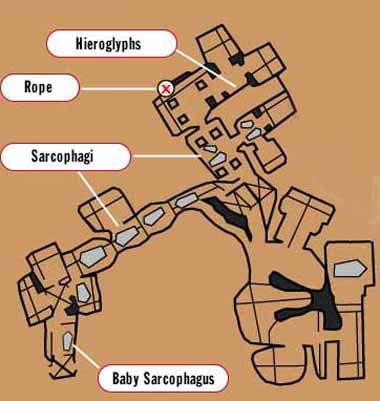
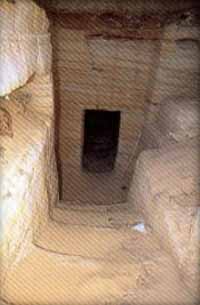
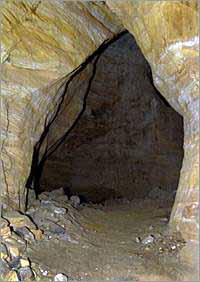
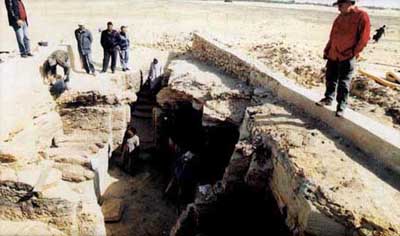
Archaeologists and restorers used ropes, ladders, dust and jagged rock
to uncover unique statues, colorful wall reliefs, pottery and jewelry.
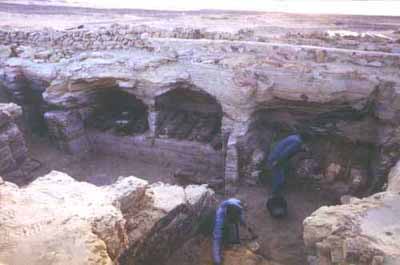
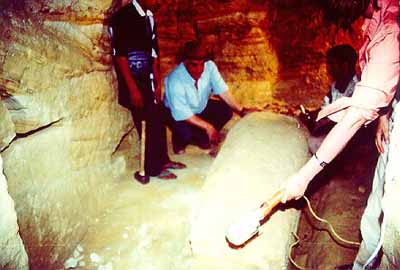
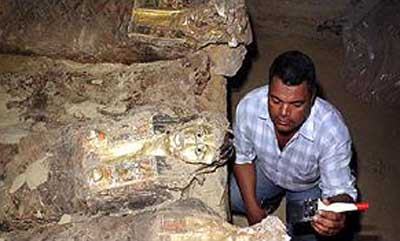
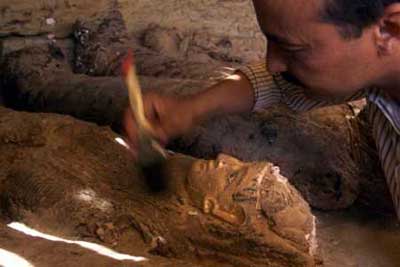
Four types of mummies were eventually uncovered:
- Mummies which are guilded, covered with a very thin layer of gold;
- Mummies covered with cartonage and scenes depicted, such as gods and goddesses. For example, Anubis of the embalment, Osiris, Isis, and the four children of Horus as well as the god Toth. All these gods are connected with the judgement;
- Mummies inside anthropoid coffins (these are coffins made of pottery with human faces);
- Mummies wrapped with linen.
The first excavation uncovered four tombs holding 105 mummies in good condition, showing the richness of the people of that time period. Artifacts were found near the mummies, such as statues of mourning ladies made of pottery. Other artifacts, such as different types of pottery in the shapes of God Bes, the dwarf god of pleasure and fun. Artifacts including bracelets, earrings and coins. This find is dated from the Greek Period to the Roman Period.
One of the mummies is a guilded lady with her head turned toward the face of her husband with love and affection. Some mummies were buried as a family group, the mummies of the children covered with gold. One woman had a crown with four decorative rows of red-colored curls. Beneath the crown, the hairstyle is similar to that of Terracotta statues.
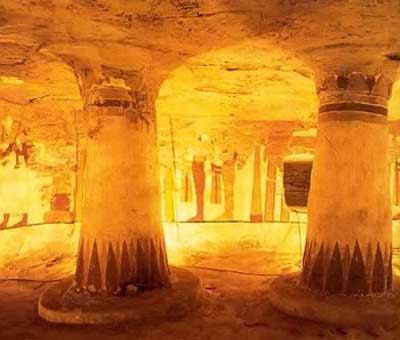
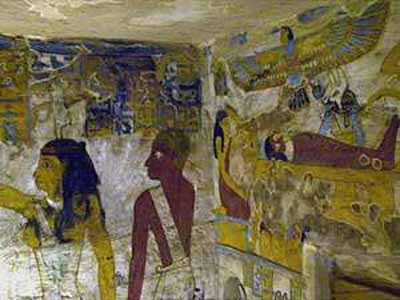
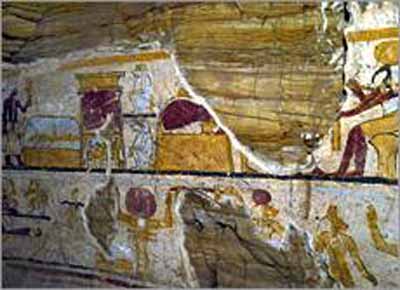
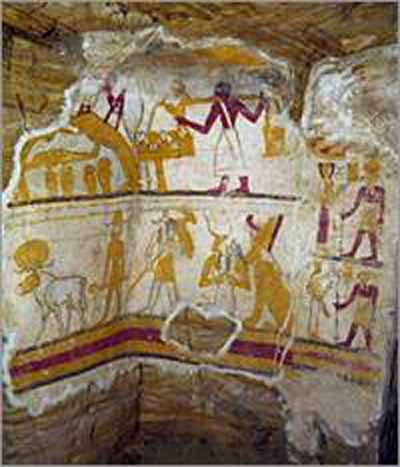
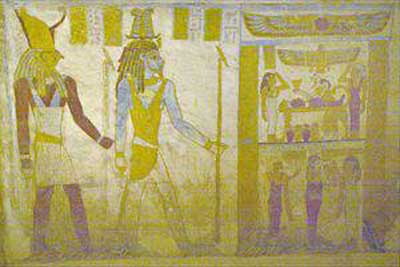
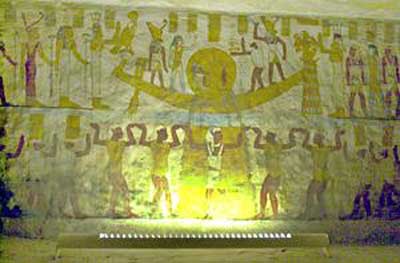
Decorative scenes show an abbreviated form of the judgement of the dead. In these scenes we see the god Osiris on his throne while Anubis weighs the heart of the dead against the feather of Maat. Meanwhile, Thoth records the result of the weighing process and reports it to Osiris.
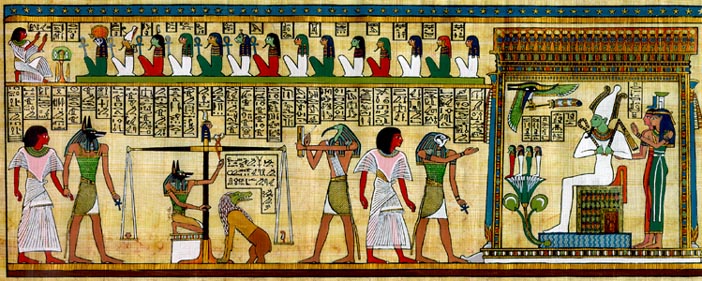
Anubis, who is portrayed on the mummies, played an important role in several ways. First is his well attested role in the judgement scenes - it is he who operates the scale on which the heart is weighed against the feather. Second is his performance of the embalming - a basic condition for rebirth. Anubis protects the body of the deceased and assists in its revival. Therefore, we find Anubis in the representations on coffins and mummy masks performing mummification rites.
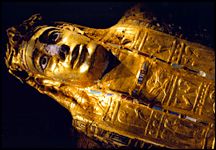
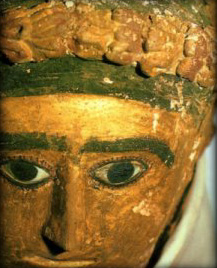
Also uncovered were mummies, in porcelain caskets or canvas wrappings, untouched by tomb robbers even though they were found in an area where villagers collected stone for building. The mummies are covered with a thin layer of gold and wearing gypsum masks. Sumptuous gilded death masks depict lifelike faces of real people, rather than stereotypical images.
Packed tightly in small caves carved into rock, the mummies still bore colorful scenes painted by mortuary artists. One mask showed people bearing offerings to ancient Egyptian gods. Another had a crown with the insignia of Horus, the principal deity of living rulers.
Some of the painted dead looked not at the intruder but at each other - as they had, undisturbed, for almost two millennia. In one corner a woman lay by her husband, her face turned affectionately towards him.
Families of men, women, children and babies rested in death together, some wrapped and embalmed in plain linen but many cased in cartonage, a durable plaster-coated pasteboard of linen and papyrus, with painted faces, elaborately gilded waistcoats and complex religious scenes.
Each mask was different, as were the visages painted on terracotta sarcophagi in an adjoining tomb. Not only had the bodies been preserved, but so had the expressions, even the hairstyles of the dead.
One of the mummies was about five feet in height. She had a beautiful gilded plaster crown with four decorative rows of red curls ending in spirals that framed her forehead and extended behind her ears.
The research continues.




0 comments:
Post a Comment